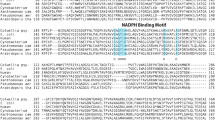Abstract
Effects of copper on the activity and oxidative inactivation of yeast glutathione reductase were analyzed. Glutathione reductase from yeast was inhibited by cupric ion and more potently by cuprous ion. Copper ion inhibited the enzyme noncompetitively with respect to the substrate GSSG and NADPH. The Ki values of the enzyme for Cu2+ and Cu+ ion were determined to be 1 and 0.35 μM, respectively. Copper-dependent inactivation of glutathione reductase was also analyzed. Hydrogen peroxide and copper/ascorbate also caused an inactivation with the cleavage of peptide bond of the enzyme. The inactivation/fragmentation of the enzyme was prevented by addition of catalase, suggesting that hydroxyl radical produced through the cuprous ion-dependent reduction of oxygen is responsible for the inactivation/fragmentation of the enzyme. SDS-PAGE and TOF–MS analysis confirmed eight fragments, which were further determined to result from the cleavage of the Met17-Ser18, Asn20-Thr21, Glu251-Gly252, Ser420-Pro421, Pro421-Thr422 bonds of the enzyme by amino-terminal sequencing analysis. Based on the kinetic analysis and no protective effect of the substrates, GSSG and NADPH on the copper-mediated inactivation/fragmentation of the enzyme, copper binds to the sites apart from the substrate-sites, causing the peptide cleavage by hydroxyl radical. Copper-dependent oxidative inactivation/fragmentation of glutathione reductase can explain the prooxidant properties of copper under the in vivo conditions.





Similar content being viewed by others
References
Aust SD, Miller DM, Samokyszyn VM (1990) Iron redox reactions and lipid peroxidation. Methods Enzymol 186:457–463
Fridovich I (1995) Superoxide radical and superoxide dismutases. Annu Rev Biochem 64:97–112
Gaetke LM, Chow CK (2003) Copper toxicity, oxidative stress, and antioxidant nutrients. Toxicology 189:147–163
Gutierrez-Correa J, Stoppani AO (1997) Inactivation of yeast glutathione reductase by Fenton systems: effect of metal chelators, catecholamines and thiol compounds. Free Radic Res 27:543–555
Habtemariam S, Dagne E (2009) Prooxidant action of knipholone anthrone: copper dependent reactive oxygen species generation and DNA damage. Food Chem Toxicol 47:1490–1494
Hadi SM, Ullah MF, Shamim U, Bhatt SH, Azmim AS (2010) Catalytic therapy of cancer by ascorbic acid involves redox cycling of exogenous/endogenous copper ions and generation of reactive oxygen species. Chemotherapy 56:280–284
Halliwel B (1995) Antioxidant characterization. Methodology and mechanism. Biochem Pharmacol 49:1341–1348
Jomova K, Valko M (2011) Advances in metal-induced oxidative stress and human disease. Toxicology 283:65–87
Khan HY, Zubair H, Faisal M, Ullah MF, Farhan M, Sarkar FH, Ahmad A, Hadi SM (2013) Plant polyphenol induced cell death in human cancer cells involves mobilization of intracellular copper ions and reactive oxygen species generation: A mechanism for cancer chemopreventive action. Mol Nutr Food Res. doi: 10.1002/mnfr.201300417
Koch KA, Peña MM, Thiele DJ (1997) Copper-binding motifs in catalysis, transport, detoxification and signaling. Chem Biol 4:549–560
Murakami K, Tsubouchi R, Fukayama M, Ogawa T, Yoshino M (2006a) Oxidative inactivation of reduced NADP-generating enzymes in E. coli: iron-dependent inactivation with affinity cleavage of NADP-isocitrate dehydrogenase. Arch Microbiol 186:385–392
Murakami K, Haneda M, Naruse M, Yoshino M (2006b) Prooxidant action of rhodizonic acid: transition metal-dependent generation of reactive oxygen species causing the formation of 8-hydroxy-2′-deoxyguanosine formation in DNA. Toxicol In Vitro 20:910–914
Murakami K, Haneda M, Makino T, Yoshino M (2007a) Prooxidant action of furanone compounds: implication of reactive oxygen species in the metal-dependent strand breaks and the formation of 8-hydroxy-2′-deoxyguanosine in DNA. Food Chem Toxicol 45:1258–1268
Murakami K, Haneda M, Qiao SL, Naruse M, Yoshino M (2007b) Prooxidant action of rosmarinic acid: transition metal-dependent generation of reactive oxygen species. Toxicol In Vitro 21:613–617
Murakami K, Tsubouchi R, Fukayama M, Qiao SL, Yoshino M (2009) Iron-dependent inactivation with affinity cleavage of pyruvate kinase from rabbit muscle. Biol Trace Elem Res 130:31–38
Ookawara T, Kawamura N, Kitagawa Y, Taniguchi N (1992) Site-specific and random fragmentation of Cu, Zn-superoxide dismutase by glycation reaction. Implication of reactive oxygen species. J Biol Chem 267:18505–18510
Predki PF, Harford C, Brar P, Sarkar B (1992) Further characterization of the N-terminal copper(II)- and nickel(II)-binding motif of proteins. Studies of metal binding to chicken serum albumin and the native sequence peptide. Biochem J 287(Pt 1):211–215
Serafini MT, Romeu A, Arola L (1989) Zn (II), Cd (II) and Cu (II) interactions on glutathione reductase and glucose 6-phosphate dehydrogenase. Biochem Int 18:793–802
Shinar E, Navok T, Chevion M (1983) The analogous mechanisms of enzymatic inactivation induced by ascorbate and superoxide in the presence of copper. J Biol Chem 258:14778–14783
Tandogan B, Ulusu NN (2010) Inhibition of purified bovine liver glutathione reductase with some metal ions. J Enzym Inhib Med Chem 25:68–73
Valko M, Morris H, Cronin MT (2005) Metals, toxicity and oxidative stress. Curr Med Chem 12:1161–1208
Williams CH Jr (1976) Flavin containing dehydrogenases. In: Boyer DP (ed) The enzymes, vol 13, 3rd edn. Academic Press, New York, pp 89–173
Xiao Y, Chen D, Zhang X, Cui Q, Fan Y, Bi C, Dou QP (2010) Molecular study on copper-mediated tumor proteasome inhibition and cell death. Int J Oncol 37:81–87
Yoshino M, Murakami K (2009) A graphical method for determining inhibition constants. J Enzym Inhib Med Chem 24:1288–1290
Yoshino M, Haneda M, Naruse M, Hla Htay H, Tsubouchi R, Qiao SL, Li WH, Murakami K, Yokochi T (2004) Prooxidant activity of curcumin: copper-dependent formation of 8-hydroxy-2′-deoxyguanosine in DNA and induction of apoptotic cell death. Toxicol In Vitro 18:783–789
Zheng LF, Dai F, Zhou B, Yang L, Liu ZL (2008) Prooxidant activity of hydroxycinnamic acids on DNA damage in the presence of Cu(II) ions: mechanism and structure-activity relationship. Food Chem Toxicol 46:149–156
Author information
Authors and Affiliations
Corresponding author
Rights and permissions
About this article
Cite this article
Murakami, K., Tsubouchi, R., Fukayama, M. et al. Copper-dependent inhibition and oxidative inactivation with affinity cleavage of yeast glutathione reductase. Biometals 27, 551–558 (2014). https://doi.org/10.1007/s10534-014-9731-x
Received:
Accepted:
Published:
Issue Date:
DOI: https://doi.org/10.1007/s10534-014-9731-x




